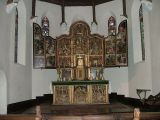| |
|
Oxburgh
Hall chapel of St Margaret and Our Lady, Oxborough
 |
|
Landed
recusant families, that is to say those who
refused to conform to the new model Church of
England, were placed in a curious relationship
with their villagers. While not sharing in
Anglican worship, they were often responsible for
presenting the Rector to the Living, and were
certainly expected to apply their patronage and
pay for the upkeep of the church. Meanwhile, they
retained their own Catholic Priest, and heard
Mass in a small chapel in their House - or, if
they were as rich as the Bedingfields of Oxburgh
Hall, in a purpose-built chapel in the grounds.
We arrived at the Hall shortly before closing
time, but as we were only really interested in
the chapel it didn't matter too much. I have to
say though that the Hall magnificent, as you can
see from the images below. If you think you've
seen it before that's because its been used loads
of times on posters, calendars and books, not
least the cover of the Norfolk Pevsner. |
Whatever
must it be like to live in such a place? Well, you'd be
in the top band for council tax for a start, and the
heating bills must cause a few sleepless nights. The
Bedingfields probably handed it over to the National
Trust with a sigh of relief.
The
current chapel dates from the 1830s, and as such is an
intriguing example of English Catholic architecture
before either the restoration of the heirarchy to England
or the Oxford Movement and Camden Society-inspired gothic
revival. The architect was not Pugin, as is sometimes
suggested, and in fact the great quality of the design is
its restraint. The Diocese claim to use it four times a
year for what must essentially be showpiece Masses
(although the National Trust later denied this), but I
understand it is still used privately as well.
The chapel
sits down at the northern end of the site, overlooking
the meadows beyond. Externally it is simple but pleasing,
particularly so because of its use of red brick. You
enter by going around to the north side.
We went
in, and the inside was breathtaking, beautiful. Directly
opposite the entrance is Henry Paston-Bedingfield's
mausoleum, and the light all around is filtered through a
collection of medieval and continental glass. But pride
of place, up at the east end, goes to the wonderful
Antwerp triptych. Constructed in the 19th century from a
variety of 16th century resources, it dominates the small
chapel in a way these things rarely do the cathedrals in
which they are usually found.
At this
point I did something so woefully foolish that I still
occasionally kick myself for it. I went to photograph the
triptych without switching my camera to silent mode, or
disengaging the flash.
I suppose
that it took about two seconds for an official to step
out of the shadows. "Sorry sir, no photography
inside National Trust property. Security reasons."
Curses. I was caught bang to rights. Instead of carefully
positioning myself in a position where I could brace the
camera and take silent flashless shots, I had given the
game away. Poor DD hadn't even got his camera out.

As you can
see, I did manage a shot of the triptych, so I suppose
that some international art thief will see it, buy a
National Trust membership and carry it away in a transit
van. Of course, it may actually be that the injunction
against photography exists so that the National Trust can
sell more postcards, guide books and tea towels, but
"No photography, sir. Fund-raising reasons"
wouldn't be quite so compelling.
The
guardian turned out to be very affable, and we discussed
the stained glass as if either of us knew anything about
it. I kept hoping he would offer to let me photograph it,
but he didn't. So I shall have to go back some time and
be more discreet.
I once
spent half an hour taking photos in the National
Trust-owned church at Staunton Harald in Leicestershire.
It was only when I came to leave that the wry, sprightly
guardian explained the rules. He had spent the last
thirty minutes watching me without saying anything. I was
so grateful I spent nearly £10 on souvenirs.
Postcript,
June 2005: Teresa Squires, House Steward at the
Hall, was alerted by, as she put it, 'a concerned
National Trust volunteer', and contacted me: I am
most concerned about your puerile comments regarding the
"sneak" photography. The National Trust has a
No Photography rule for a number of good reasons, of
which one is security. If you had taken the trouble to
enquire of the steward, you would have found out that the
No Photography rule only applies during public visiting
hours, and an arrangement can be made to photograph for
bona fide reasons at another time. Your irresponsible
attitude is likely to cause others to think they can buck
the system with impunity. Remember, the National Trust is
a conservation charity, not a subsidised Government
organisation. Yes, it is most unlikely that someone will
steal this particular altarpiece, but art crime is on the
increase everywhere. If you are truly concerned with
recording and disseminating knowledge of church history,
I would expect you to show a little more respect.
Postscript:
November 2009: Despite the concerns and
protestions of Ms Squires, the National Trust has since
relaxed its rules on photography. You can now take
photographs in most NT properties, including this one,
although the use of flash is still not allowed. I will go
back.
Simon Knott, January 2005
|
|
|
